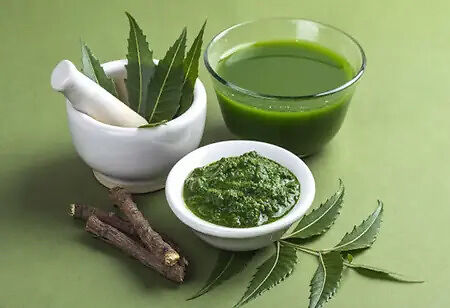
Neem: The Sweetness of a Bitter Plant


The common medicine for almost all 90’s kids when their digestive tract got infected was Neem Oil, which has many medicinal properties. Azadirachta Indica is the scientific name of neem and is a tree in the mahogany family, Meliaceae. It is one of two species in the genus Azadirachta and is native to the Indian subcontinent. It is typically grown in tropical and subtropical regions. In India, Andhra Pradesh is the highest producer of neem. It is considered the state tree of the state. Neem is recognized as a natural product that has much to offer in solving global agricultural, environmental, and public health problems.
In fact, neem has diverse uses. For instance, neem provides many useful and valuable everyday ingredients for the pesticide and pharmaceutical industries. The solid residue that deposits after oil is removed from grain is used as a fertilizer and soil conditioner. Additionally, wood is valued from trees for construction, furniture, and fuel. The skin is peeled for gum and extracted for tannins and dental care products. The leaves are also used as emergency feed for livestock. And lush flowers are a source of precious honey.
But of all these products, oil is perhaps the most commercially important. In composition, it is much like other vegetable oils, composed primarily of triglycerides of oleic, stearic, linoleic, and palmitic acids. Neem leaves also have medicinal power. Neem leaf meal was analyzed in a study that found that it has 18.10 percent crude protein and relatively high crude fiber of about 15-56 percent. Though the gross energy content was high at 4.16 kcal/g, the metabolizable energy was low.
Neem Oil Extraction Process
In order to extract the oil from the seed, the seeds are first broken open and the kernels separated. The kernels are contained by the industrial expellers or in hand- or bullock-operated wooden presses. The oil obtained will be as high as 50 percent of the weight of the kernel. The oil extracted should undergo a purification process.
Neem oil refining is currently a laborious and costly process. This process has been used industrially for a long time. Instead of squeezing out the oil, the kernels can be extracted first with alcohol and then with Hexane.
Alcohol removes bitterness and odorous substances, and Hexane recovers the oil. This stepwise extraction fortifies both the flour and the oil. On the other hand, it requires expensive solvents and complex equipment.
Advantages of Neem
Neem belongs to the mahogany family, and the properties of its wood resemble mahogany. The size of the tree is relatively heavy with a specific gravity varying from 0.56 to 0.85, that is average, 0.68. When the tree is cut, it will have a strong smell. Even though it can be sawn, worked, polished, and glued, it must be dried carefully because it often splits and warps. When the tree is nailed by making holes, it splits easily. Moreover, it is a good construction timber and is widely used in carts, tool handles, and agricultural implements. In South India, it is a common furniture wood. The heartwood is red when first exposed, but in sunlight, it fades to reddish brown. It is aromatic, beautifully mottled, narrowly interlocked, and medium to coarse in texture. It is subject to only slight shrinkage and can be readily worked by hand or machine. Although it lends itself to carving, it does not take a high polish.
Soaps
The soap industry uses neem oil mainly. However, much of it goes to small-scale specialty soaps; large-scale producers also use it, mainly because it is cheap. The crude oil is used to produce coarse laundry soaps. In addition, more expensive soaps are made by saponifying the crude oil and distilling the resulting fatty acids before adding the lye. The resulting almost colorless and odorless product is suitable for top-quality toilet and laundry soaps.
Cosmetics
When it comes to beauty aids, neem will be placed in the first position. Powdered leaves, for example, are a major component of at least one widely used facial cream. Purified neem oil is also used in nail polish and other cosmetics.
Fuel
Neem produces several useful fuels. Oil is burned in lamps all over India. Wood has also been used as firewood since ancient times. In addition, oil-free seed husks, which make up the bulk of the waste from pesticide manufacturing, are primarily used as fuel. As it has good growth and valuable firewood, it has become the most important plantation species in northern Nigeria. It is also grown for fuel in the main cities. The charcoal made from this neem plant is of superior quality and has a slightly lower calorific value than charcoal.
Resin: exudate can be extracted from the trunk by scratching the bark. This protein-rich material will not have a substitute for polysaccharide bonds such as gum arabic.
Honey: In some parts of Asia, neem honey is sold at a high price. And people grow neem plants to encourage beekeeping.
Food: There are strange reports of people eating neem. Leaf tea can be harmful, especially when consumed in large quantities over a long period. However, Mahatma Gandhi, who appreciated the nutritional value of vegetables, prepared Neem His Leaf His Chutney and still believes it. It is said that they ate it with a bitter aftertaste taste. Recently, the discovery of a neem tree with rare sweet leaves has been reported.
Pulp: The pericarp accounts for about half of the weight of the neem fruit and also produces a large amount of pulp when processed to obtain the seed. This neem pulp is a promising substrate for methane gas production and also serves as a carbohydrate-rich base for other industrial fermentations.